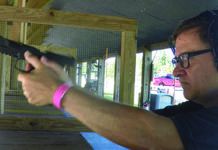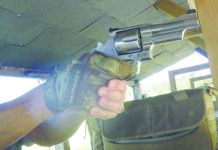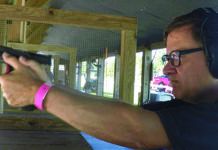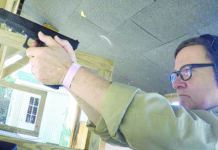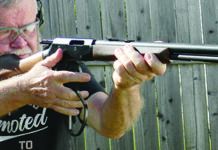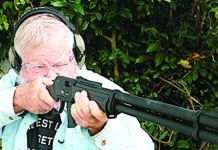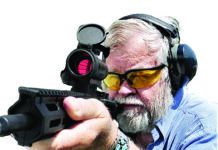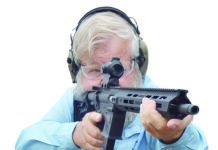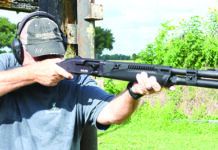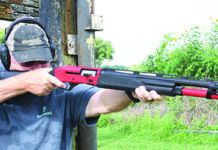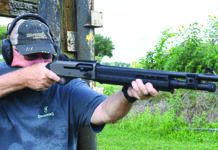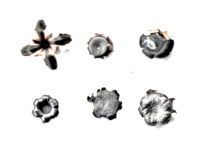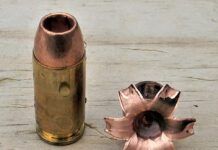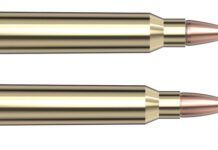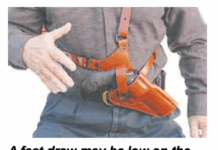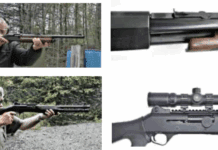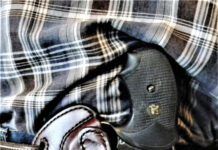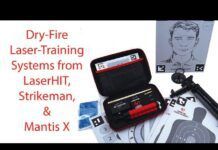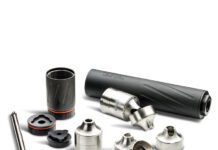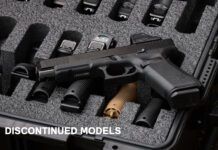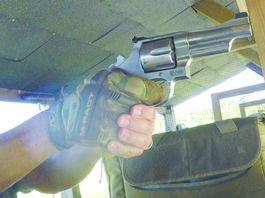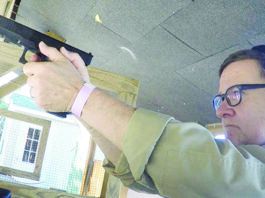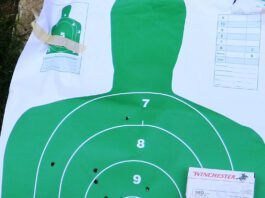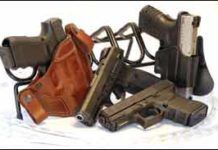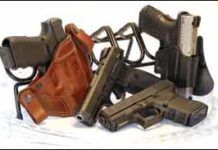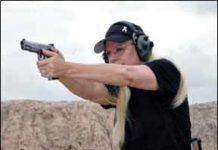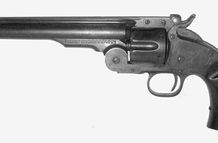MasterPiece Arms Defender Pistol Now California Compliant
PARA USA Exits Rifle Market
New Polymer Forties: Glock, Springfield, Ruger Shoot It Out
The 10mm pistol cartridge was developed to fill the gap between 9mm and 45 ACP firepower. In 1989 its popularity was spurred by the FBI choosing 10mm as its favored caliber. At the time, Colt successfully chambered a 1911 for 10mm, the Colt Delta Elite. Smith & Wesson tried to adapt its line of semi-automatic pistols as well. Durability became an issue. But then pistol makers found out it was easier to increase the strength of their 9mm fleet to handle another round developed almost concurrently, the 40 S&W round, rather than tool up to withstand the more powerful 10mm rounds. We could resort to revolver jargon and refer to 10mm ammunition as 40 Magnum. That's because both 40 S&W and 10mm ammunition share the same diameter bullet, but the 10mm case is 0.140 inch longer.
Time has not quite eclipsed the standard 10mm round, but it is now decidedly less popular than the 40 S&W it sired. The big reason: the 40 S&W delivers noticeably more power than the 9mm, but the larger high-velocity round can still be packed into same frame as current 9mm pistols with little structural change.
This brings us to our current roster of test guns. The Ruger SR40 began life as a 9mm pistol, and since our test of the SR9 in the December 2007 issue, a compact version is now available in both calibers. Likewise, the roots of the Glock 23 Gen4 can be traced to the 9mm Model 19, which itself was the compact version of the G17 service pistol. The Springfield Armory XDM40 Compact is somewhat of a hybrid with characteristics of both a compact and full-size pistol. Developed from a foreign-manufacture 9mm service pistol, the XDM Compact offers a shortened grip for better concealment and a full-length 16-round magazine that includes a grip extension. Our fourth pistol is a true subcompact, and it shoots the same bullet as our other test guns but from a longer case that packs more powder. The Glock Model 29 chambers 10mm ammunition, from which 40 S&W was developed. Since the 10mm originally lost favor due in part to its recoil, we wondered how much we'd like shooting the round in such a small package as the G29.
New Polymer Forties: Glock, Springfield, Ruger Shoot It Out
The 10mm pistol cartridge was developed to fill the gap between 9mm and 45 ACP firepower. In 1989 its popularity was spurred by the FBI choosing 10mm as its favored caliber. At the time, Colt successfully chambered a 1911 for 10mm, the Colt Delta Elite. Smith & Wesson tried to adapt its line of semi-automatic pistols as well. Durability became an issue. But then pistol makers found out it was easier to increase the strength of their 9mm fleet to handle another round developed almost concurrently, the 40 S&W round, rather than tool up to withstand the more powerful 10mm rounds. We could resort to revolver jargon and refer to 10mm ammunition as 40 Magnum. That's because both 40 S&W and 10mm ammunition share the same diameter bullet, but the 10mm case is 0.140 inch longer.
Time has not quite eclipsed the standard 10mm round, but it is now decidedly less popular than the 40 S&W it sired. The big reason: the 40 S&W delivers noticeably more power than the 9mm, but the larger high-velocity round can still be packed into same frame as current 9mm pistols with little structural change.
This brings us to our current roster of test guns. The Ruger SR40 began life as a 9mm pistol, and since our test of the SR9 in the December 2007 issue, a compact version is now available in both calibers. Likewise, the roots of the Glock 23 Gen4 can be traced to the 9mm Model 19, which itself was the compact version of the G17 service pistol. The Springfield Armory XDM40 Compact is somewhat of a hybrid with characteristics of both a compact and full-size pistol. Developed from a foreign-manufacture 9mm service pistol, the XDM Compact offers a shortened grip for better concealment and a full-length 16-round magazine that includes a grip extension. Our fourth pistol is a true subcompact, and it shoots the same bullet as our other test guns but from a longer case that packs more powder. The Glock Model 29 chambers 10mm ammunition, from which 40 S&W was developed. Since the 10mm originally lost favor due in part to its recoil, we wondered how much we'd like shooting the round in such a small package as the G29.
Colt Defense Launches Facebook Page, Sponsors Rifle Giveaway
Glock announces voluntary replacement of recoil spring assemblies in Gen4 pistols
Requirements for Transporting Firearms, Firearm Parts and Ammunition on Commercial Aircraft
GunReports.com Video: 3-Gun Matches
Seven Common Misconceptions That Can Get You Killed: From Front Sight
NM Gov gets perfect score on CCL renewals
New 1911 45 Pistols For Less Than $1000: Ruger, Springfield, Magnum Research
The year 2011 marks the 100-year anniversary of the introduction of the John Browning's most successful pistol. The initial design was actually completed about 1907, but after acceptance by the U.S. Military some four years later, it became known as the 1911 and was chambered for 45 ACP (Automatic Colt Pistol).
To recognize this achievement, we found three affordable 1911-style 45s introduced in the year 2011. They are the Ruger SR1911 No. 6700 45 ACP, $799; Springfield Armory's $939 Range Officer; and the $799 Desert Eagle 1911G from Magnum Research. The introduction of yet another 1911 from Springfield Armory isn't surprising; the company has essentially built its formidable reputation on 1911 pistols. For Ruger and Magnum Research, however, these pistols are their first tries at producing 1911s.
All three models featured a 5-inch barrel on a full size frame offering a flat profile checkered mainspring housing below an enhanced grip safety. Thumb safeties were left side only. The front strap of each pistol remained smooth. Each pistol utilized an aluminum trigger that was lined at its contact surface and relieved to reduce weight. Only one gun, the Springfield Armory Range Officer, offered an adjustable rear sight. Only the Desert Eagle was fit with a full-length guide rod. The Ruger pistol alone was fit with three-dot sights and offered a noticeably taller magazine release button. Otherwise, these three pistols were nearly identical.
Besides their basic functionality, these pistols are interesting for another reason. They individually include advancements in 1911 design and finish that shooters of this time take for granted. To better illustrate some of these so-called advancements, we compared our test pistols to a 100th Anniversary, we shot them alongside a 100th Anniversary Limited Edition 1911 Government model from Cylinder & Slide (www.Cylinder-Slide.com). The retro-1911 is being built for production by Cylinder & Slide, Bill Laughridge's Fremont, Nebraska, custom house famous for the production of high-quality 1911 parts. On the outside of the current pistols, it is easy to see an improved grip safety, beveled magazine well, aluminum trigger adjustable for overtravel, oversized or ambidextrous thumb safeties, a lowered and flared ejection port, reduced mass hammer and high visibility sights both adjustable and low profile. Most of the upgrades that define the modern era 1911 were developed in the final quarter of the 20th century.
Today's features are supposed to help the operator shoot the gun faster, safer, and more comfortably, and those upgrades have become more economical. Not long ago, our test pistols would likely have sold in the $1400 range. The cost of high-quality 1911s first took a notable drop with the introduction of Computer Numerically Controlled (CNC) machining. This made accurately machined parts more abundant, reducing hand fitting.
Smith & Wesson .45 Model No. 3 Schofield Revolvers
In 1870, the U.S. Army contracted with Smith & Wesson to deliver 1,000 of their revolutionary new top-break Model No. 3 revolvers in .44 S&W caliber. The delivery to Springfield Armory of the 800 blued and 200 nickel-plated revolvers took place in 1871. After issuing the new revolvers to the cavalry for a period of field trials, the Army came to the conclusion that the S&W was too complicated and delicate for service use, and decided not to purchase additional revolvers.


